An HR system (also known as an HCM system) is a tool that assists you in managing various HR functions. The HR system is typically a central part of the IT landscape as it contains all HR master data (employee data). Consequently, the HR system is integrated into processes that occur outside the HR department.
Highlights of the article:
|
An HR system is a digital system used to increase efficiency within an organisation by automating processes, managing HR-related tasks, and providing reports and analytics. The HR system automates and facilitates everything from the administration of employment contracts and employee evaluations to managing absence, generating personnel reports, and much more.
An HR system also makes it possible for employees to manage their own data, therefore significantly reducing the administrative burden on HR while increasing efficiency at the same time. For managers, it is also possible to access reports that support decision-making and strategising based on data on their own employees.
HR systems are sometimes referred to as HRMS (Human Resource Management System), HRIS (Human Resources Information System), or HCM system (Human Capital Management). These terms are often used interchangeably, but to maintain consistency and avoid confusion, we will use the term "HR system" here.
For a company to make the most out of an HR system, it is important for it to be customised to fit the company's needs. For some, a few functionalities may be sufficient, while others may require the full range of offers. Scalability is also important, so that additional functionalities can be added as the company grows. Here is an overview of some of the key modules and functions that a good HR system should include.
HR master data is the foundation for all HR-related tasks. It is also the key information that IT needs to handle correct and secure access to systems, manage licenses, and order IT equipment correctly.

Master data is data that contains basic information about employees, such as name, role, title, qualifications, department, address, phone number, email address, and salary level. It is important for the master data to always be accurate and up to date to avoid errors and delays in HR processes. A good HR system should therefore have a function to manage HR master data in a way that makes it easy to update and maintain them – namely self-service.
Secure, reliable, and automated management of master data lays the foundation for efficient processes that provide benefits across the entire organisation. It is therefore important for the HR system to sit centrally in the system landscape and be closely integrated with other important business systems, such as payroll systems, ERP systems, active directory, and the like. This will ensure that correct employee data automatically flows across all systems.
Modern HR master data systems reduce paperwork, automate time-consuming processes, and provide self-service capabilities for managers and employees. They also ensure that your HR data is secure and stored in accordance with applicable GDPR regulations, including the use of change logs and automatic deletion routines.
A good HR system should also be able to integrate with a payroll system and include functionality for managing salary adjustments. For many, the salary review process can be hectic and stressful. The process is often poorly defined and relies on spreadsheets containing sensitive personal data that are exchanged among those involved. In some cases, undocumented ad-hoc evaluations may also form the basis for adjustments, making the situation even more challenging.
For larger departments and organisations, the number of administrative tasks can become overwhelming, and managers may often feel unsupported in the process. This makes it difficult for them to make informed decisions within the provided guidelines. By using an HR system with features for salary adjustments, such as budget allocation, employee evaluations, real-time budget adjustments, and documentation, the process becomes simple and efficient.
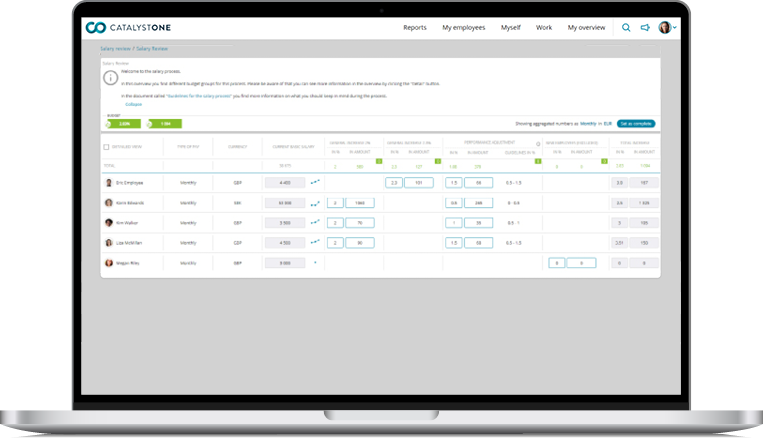
This also ensures that managers and HR can work effectively, make informed decisions, prevent sensitive salary information from being compromised, and adhere to budgets. Additionally, the entire process is thoroughly documented, making it easier to evaluate and review.
Employee appraisals are standardised conversations between an employee and a manager, aimed at providing the employee with an opportunity to discuss their role in the company, goals, development needs, and for the manager to provide feedback and support.
Appraisals also cover personal development, goal setting, and skills enhancement, which contribute to having motivated employees and ensuring everyone is working towards the same objectives.
Conducting appraisals requires both time and resources. A modern HR system digitises the entire process and ensures that everything is documented along the way. This means that employees, HR, and managers can track progress over time, while the company saves time and money.
Traditionally, employee evaluations have been conducted once a year, but nowadays, there is an expectation for more frequent follow-up with employees. Regular conversations facilitate positive dialogue and enable goal adjustments throughout the year, aligning with modern management practices.
A good onboarding process ensures that new hires feel welcomed and integrated into the organisation quickly and contributes to increasing employee engagement and loyalty. Meanwhile, a good offboarding process facilitates a smooth departure for employees leaving the company while protecting your organisation from security risks.
An unstructured onboarding and offboarding process reflects poorly on your company, both internally and externally. An HR system solves this by initiating onboarding activities from the moment the new employee accepts the offer. Your new colleague feels immediately seen and taken care of, while you can gather necessary information in advance, order materials, and be prepared for their first day of work.
The HR system also facilitates a structured and professional offboarding process. Remember that former employees can be some of the best—or worst—ambassadors for your brand, so it's crucial that those leaving the organisation depart with a positive impression.
From both a security and financial perspective, IT will greatly appreciate a structured offboarding process. Automatic notifications can ensure that access to systems and information is immediately revoked, and costly software licenses are canceled at the right time.
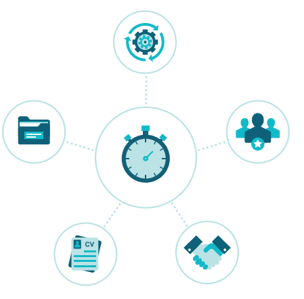
An HR system also helps ensure that all employees have the same positive onboarding and offboarding experience, as each step in these processes can be predefined, and all involved parties will receive notifications and reminders about their tasks.
Competence development is an important part of the HR function as it enables competency mapping, identifying strengths, development areas, and competency gaps. This makes it easier to plan for future competency needs and provides employees with a clear direction for expanding their skills and knowledge.
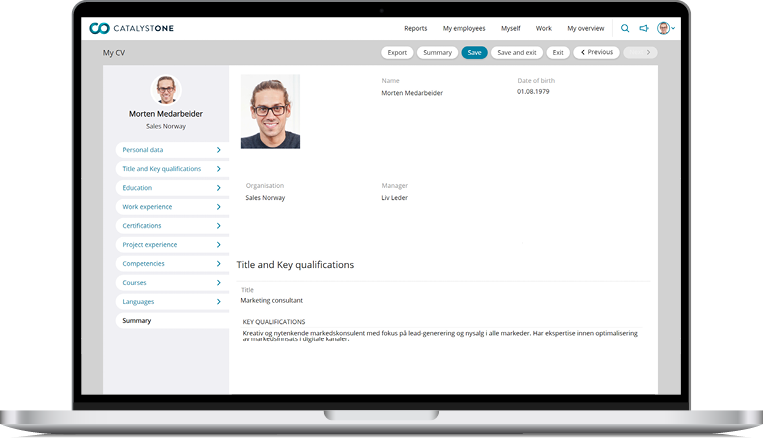
An HR system with robust competence development features allows organisations to more effectively manage and track training and development activities to ensure alignment with organisational goals and strategies. This also ensures that you stay updated on employees' certifications and receive notifications when critical competencies or certifications are nearing expiration.
Absence management is a crucial function in an HR system, whether it's related to vacation, illness, leaves of absence, or other types of absences. The system should be able to track and manage absence approvals, absence statistics, and absence reporting. This can be valuable for the HR department to plan and manage staffing needs, and for employees to keep track of and manage their own absences.
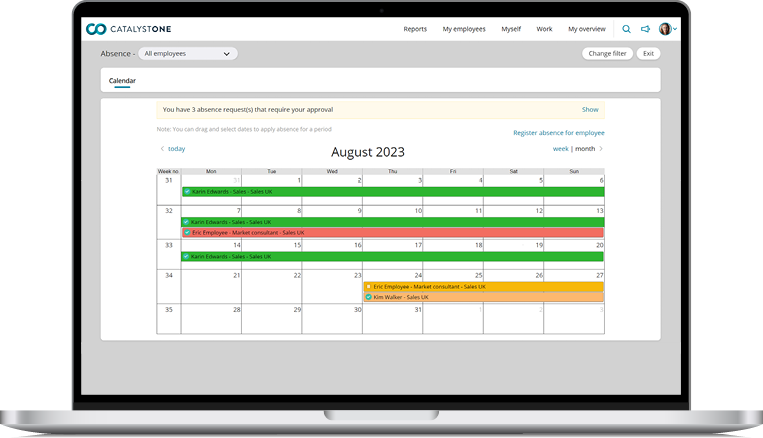
Self-service absence management allows employees to register different types of absences in an interactive calendar that triggers a process, notifies the relevant manager, and, in certain cases, sends the information to the ERP and/or payroll system through integration. Automation simplifies the follow-up for managers, and absence data flows seamlessly to the payroll system for a more streamlined process.
Since an HR system contains a wealth of valuable data, it's essential that it includes functionality for reporting and analysis, enabling you to generate reports on everything from employee information to payroll and personnel matters. These reports allow you to analyse trends, measure relevant KPIs, extract updated statistics, and gain deeper insights that support critical strategic decisions.
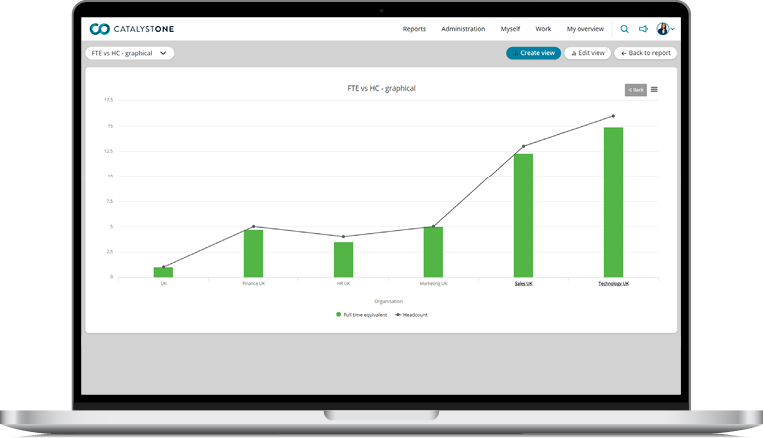
With an HR system, reports and analyses can be easily shared, and those who need the information can access it themselves. This means that HR no longer needs to respond to requests for numbers and reports. The data can also be exported to other business analysis tools (such as Microsoft Excel, or Power BI) and integrated into larger, more in-depth analyses.
The cost of an HR system can vary widely depending on factors such as the size of the business and the required functionality.
Some HR systems may have an upfront setup fee in addition to an annual licensing fee. This can range from a few thousand to several hundred thousand, depending on the functionality of the system, the complexity of processes and integrations, and the size of the business. There are also free HR systems, but these usually have limited functionality.
It's also important to consider the upfront costs and ongoing maintenance of the system, as well as the cost of training employees to use it. It's a good idea to budget for these expenses in addition to the actual system costs. When comparing the price of different HR systems, it's also important to determine what is included. A system may appear inexpensive but require significant internal resources for implementation. Other vendors may offer some support during implementation but charge for any additional assistance that may be needed.
Ultimately, it's advisable to compare multiple options and consider what best suits your business before making a decision.
The value of a well-designed HR system is significant to a well-functioning organisation as it helps you manage your most important resource: your employees. A good HR system automates time-consuming and manual processes, making the day-to-day operations easier for HR, managers, employees, IT, and finance. By replacing manual processes with automated workflows that send out notifications to all involved parties, everyone knows exactly what needs to be done and when.
There are significant benefits to structuring and automating many tasks within a unified system. The flow of information becomes as streamlined as possible throughout the organisation. This saves resources and costs and enables HR to fulfill its modern role as a strategic business partner in the organisation. It also allows HR to focus on employee development, company culture, and organisational values necessary to achieve overarching business goals.
Our Senior Solution Consultant, Rune Riktor, has years of experience in HR system procurement processes. He has guided and developed many business cases. In this video, he provides valuable tips about creating a business case.
Watch the video to learn more about:
You can also click below to download our guide to building a business case for an HR system.
If you want to learn more about how CatalystOne's HR system can help you and your organisation, don't hesitate to book a non-binding demonstration where we can discuss your challenges and needs. We have helped hundreds of medium-sized and large Nordic companies optimise and digitise HR with CatalystOne's HR system. We would love to help you too.
I denne guiden får du våre beste tips til å utarbeide en business case for et HR-system - trinn for trinn. Innholdet er basert på årevis med erfaring og hundretalls av vellykkede innkjøpsprosesser.
Copyright © CatalystOne Solutions AS / Karenslyst Allé 2, Skøyen, 0278 Oslo, Norway